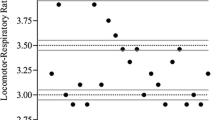Abstract
Purpose
This study compared cardio-pulmonary responses between incremental concentric and eccentric cycling tests, and examined factors affecting the maximal eccentric cycling capacity.
Methods
On separate days, nine men and two women (32.6 ± 9.4 years) performed an upright seated concentric (CON) and an eccentric (ECC) cycling test, which started at 75 W and increased 25 W min−1 until task failure. Gas exchange, heart rate (HR) and power output were continuously recorded during the tests. Participants also performed maximal voluntary contractions of the quadriceps (MVC), squat and countermovement jumps.
Results
Peak power output was 53% greater (P < 0.001, g = 1.77) for ECC (449 ± 115 W) than CON (294 ± 61 W), but peak oxygen consumption was 43% lower (P < 0.001, g = 2.18) for ECC (30.6 ± 5.6 ml kg min−1) than CON (43.9 ± 6.9 ml kg min−1). Maximal HR was not different between ECC (175 ± 20 bpm) and CON (182 ± 13 bpm), but the increase in HR relative to oxygen consumption was 33% greater (P = 0.01) during ECC than CON. Moderate to strong correlations (P < 0.05) were observed between ECC peak power output and CON peak power (r = 0.84), peak oxygen consumption (r = 0.54) and MVC (r = 0.53), while no significant relationships were observed between ECC peak power output and squat as well as countermovement jump heights.
Conclusion
Unexpectedly, maximal HR was similar between CON and ECC. Although ECC power output can be predicted from CON peak power output, an incremental eccentric cycling test performed after 3–6 familiarisation sessions may be useful in programming ECC training with healthy and accustomed individuals.





Similar content being viewed by others
Abbreviations
- B f :
-
Breathing frequency
- CMJ:
-
Countermovement jump
- CON:
-
Incremental concentric cycling test
- ECC:
-
Incremental eccentric cycling test
- g :
-
Hedges’ g
- HR:
-
Heart rate
- MVC:
-
Maximal voluntary isometric contraction
- RPE:
-
Rating of perceived exertion
- SD:
-
Standard deviation
- SJ:
-
Squat jump
- VO2 :
-
Oxygen consumption
- VO2peak :
-
Peak oxygen consumption
- V E :
-
Minute ventilation
- V t :
-
Tidal volume
- VO2 :
-
Oxygen consumption
References
Abbiss CR, Quod MJ, Levin G et al (2009) Accuracy of the Velotron ergometer and SRM power meter. Int J Sports Med 30:107–112. https://doi.org/10.1055/s-0028-1103285
Abbott BC, Bigland B, Ritchie JM (1952) The physiological cost of negative work. J Physiol 117:380–390
Amann M, Blain GM, Proctor LT et al (2010) Group III and IV muscle afferents contribute to ventilatory and cardiovascular response to rhythmic exercise in humans. J Appl Physiol Bethesda Md 1985 109:966–976. https://doi.org/10.1152/japplphysiol.00462.2010
Bobbert MF, Mackay M, Schinkelshoek D et al (1986) Biomechanical analysis of drop and countermovement jumps. Eur J Appl Physiol 54:566–573. https://doi.org/10.1007/BF00943342
Bonde-Petersen F, Henriksson J, Knuttgen HG (1973) Effect of training with eccentric muscle contractions on skeletal muscle metabolites. Acta Physiol Scand 88:564–570. https://doi.org/10.1111/j.1748-1716.1973.tb05485.x
Bridgeman LA, McGuigan MR, Gill ND, Dulson DK (2016) Relationships between concentric and eccentric strength and countermovement jump performance in resistance trained men. J Strength Cond Res. https://doi.org/10.1519/JSC.0000000000001539
Brughelli M, Van Leemputte M (2013) Reliability of power output during eccentric sprint cycling. J Strength Cond Res Natl Strength Cond Assoc 27:76–82. https://doi.org/10.1519/JSC.0b013e31824f2055
Coquart J, Tabben M, Farooq A et al (2016) Submaximal, perceptually regulated exercise testing predicts maximal oxygen uptake: a meta-analysis study. Sports Med 46:885–897. https://doi.org/10.1007/s40279-015-0465-x
Cormie P, McGuigan MR, Newton RU (2010) Changes in the eccentric phase contribute to improved stretch-shorten cycle performance after training. Med Sci Sports Exerc 42:1731–1744. https://doi.org/10.1249/MSS.0b013e3181d392e8
Cornelis N, Buys R (2016) The effects of exercise modality on maximal and submaximal exercise parameters obtained by graded maximal exercise testing. Int J Cardiol 222:538–547. https://doi.org/10.1016/j.ijcard.2016.07.190
de Hoyo M, Pozzo M, Sañudo B et al (2015) Effects of a 10-week in-season eccentric-overload training program on muscle-injury prevention and performance in junior elite soccer players. Int J Sports Physiol Perform 10:46–52. https://doi.org/10.1123/ijspp.2013-0547
Dufour SP, Lampert E, Doutreleau S et al (2004) Eccentric cycle exercise: training application of specific circulatory adjustments. Med Sci Sports Exerc 36:1900–1906
Elmer SJ, Madigan ML, LaStayo PC, Martin JC (2010) Joint-specific power absorption during eccentric cycling. Clin Biomech Bristol Avon 25:154–158. https://doi.org/10.1016/j.clinbiomech.2009.10.014
Elmer S, Hahn S, McAllister P et al (2012) Improvements in multi-joint leg function following chronic eccentric exercise. Scand J Med Sci Sports 22:653–661. https://doi.org/10.1111/j.1600-0838.2011.01291.x
Emanuele U, Horn T, Denoth J (2012) The relationship between freely chosen cadence and optimal cadence in cycling. Int J Sports Physiol Perform 7:375–381. https://doi.org/10.1123/ijspp.7.4.375
Flann KL, LaStayo PC, McClain DA et al (2011) Muscle damage and muscle remodeling: no pain, no gain? J Exp Biol 214:674–679. https://doi.org/10.1242/jeb.050112
Franchi MV, Atherton PJ, Reeves ND et al (2014) Architectural, functional and molecular responses to concentric and eccentric loading in human skeletal muscle. Acta Physiol Oxf Engl 210:642–654. https://doi.org/10.1111/apha.12225
Gibala MJ, Jones AM (2013) Physiological and performance adaptations to high-intensity interval training. Nestlé Nutr Inst Workshop Ser 76:51–60. https://doi.org/10.1159/000350256
Hansen EA, Smith G (2009) Factors affecting cadence choice during submaximal cycling and cadence influence on performance. Int J Sports Physiol Perform 4:3–17
Hedges LV (1981) Distribution Theory for Glass’s Estimator of Effect size and Related Estimators. J Educ Stat 6:107–128. https://doi.org/10.3102/10769986006002107
Hesser CM, Linnarsson D, Bjurstedt H (1977) Cardiorespiratory and metabolic responses to positive, negative and minimum-load dynamic leg exercise. Respir Physiol 30:51–67
Hoppeler H (2016) Moderate load eccentric exercise; a distinct novel training modality. Exerc Physiol 7:483. https://doi.org/10.3389/fphys.2016.00483
Hoppeler HH, Herzog W (2014) Eccentric exercise: many questions unanswered. J Appl Physiol. https://doi.org/10.1152/japplphysiol.00239.2014
Hortobágyi T, Katch FI (1990) Eccentric and concentric torque-velocity relationships during arm flexion and extension. Eur J Appl Physiol 60:395–401. https://doi.org/10.1007/BF00713506
Knuttgen HG, Petersen FB, Klausen K (1971) Oxygen uptake and heart rate responses to exercise performed with concentric and eccentric muscle contractions. Med Sci Sports 3:1–5
Laroche D, Joussain C, Espagnac C et al (2013) Is it possible to individualize intensity of eccentric cycling exercise from perceived exertion on concentric test? Arch Phys Med Rehabil 94:1621.e1–1627.e1. https://doi.org/10.1016/j.apmr.2012.12.012
Lastayo PC, Reich TE, Urquhart M et al (1999) Chronic eccentric exercise: improvements in muscle strength can occur with little demand for oxygen. Am J Physiol 276:R611-615
LaStayo PC, Pierotti DJ, Pifer J et al (2000) Eccentric ergometry: increases in locomotor muscle size and strength at low training intensities. Am J Physiol Regul Integr Comp Physiol 278:R1282-1288
LaStayo P, Pifer J, Pierotti D, Lindstedt S (2008) Electromyographic adaptations elicited by submaximal exercise in those naive to and in those adapted to eccentric exercise: a descriptive report. J Strength Cond Res 22:833–838. https://doi.org/10.1519/JSC.0b013e31816a5825
LaStayo P, Marcus RL, Dibble L et al (2013) Eccentric exercise in rehabilitation: safety, feasibility and application. J Appl Physiol. https://doi.org/10.1152/japplphysiol.00008.2013
Lechauve JB, Perrault H, Aguilaniu B et al (2014) Breathing patterns during eccentric exercise. Respir Physiol Neurobiol 202:53–58. https://doi.org/10.1016/j.resp.2014.07.007
Leong CH, McDermott WJ, Elmer SJ, Martin JC (2013) Chronic eccentric cycling improves quadriceps muscle structure and maximum cycling power. Int J Sports Med. https://doi.org/10.1055/s-0033-1358471
Mueller M, Breil FA, Vogt M et al (2009) Different response to eccentric and concentric training in older men and women. Eur J Appl Physiol 107:145–153. https://doi.org/10.1007/s00421-009-1108-4
Nadel ER, Bergh U, Saltin B (1972) Body temperatures during negative work exercise. J Appl Physiol 33:553–558
Peñailillo L, Blazevich A, Numazawa H, Nosaka K (2013) Metabolic and muscle damage profiles of concentric versus repeated eccentric cycling. Med Sci Sports Exerc. https://doi.org/10.1249/MSS.0b013e31828f8a73
Peñailillo L, Blazevich A, Numazawa H, Nosaka K (2014) Rate of force development as a measure of muscle damage. Scand J Med Sci Sports. https://doi.org/10.1111/sms.12241
Pfeiffer JJ, Quintana R, Parker DL (2005) The influence of graded exercise test selection on Pmax and a subsequent single interval bout. J Exerc Physiol 8:10–17
Sheppard J, Hobson S, Barker M et al (2008) The effect of training with accentuated eccentric load counter-movement jumps on strength and power characteristics of high-performance volleyball players. Int J Sports Sci Coach 3:355–363. https://doi.org/10.1260/174795408786238498
Thomson DA (1971) Cardiac output during positive and negative work. Scand J Clin Lab Investig 27:193–200. https://doi.org/10.3109/00365517109080207
Wisløff U, Støylen A, Loennechen JP et al (2007) Superior cardiovascular effect of aerobic interval training versus moderate continuous training in heart failure patients a randomized study. Circulation 115:3086–3094. https://doi.org/10.1161/CIRCULATIONAHA.106.675041
Acknowledgements
This study was supported by an International Postgraduate Research Scholarship that was awarded the first author.
Author information
Authors and Affiliations
Corresponding author
Ethics declarations
Conflict of interest
There was no conflict of interest.
Additional information
Communicated by Guido Ferretti.
Rights and permissions
About this article
Cite this article
Lipski, M., Abbiss, C.R. & Nosaka, K. Cardio-pulmonary responses to incremental eccentric and concentric cycling tests to task failure. Eur J Appl Physiol 118, 947–957 (2018). https://doi.org/10.1007/s00421-018-3826-y
Received:
Accepted:
Published:
Issue Date:
DOI: https://doi.org/10.1007/s00421-018-3826-y




